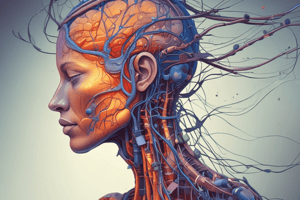Podcast
Questions and Answers
What is a common postoperative complaint associated with succinylcholine use?
What is a common postoperative complaint associated with succinylcholine use?
- Nausea
- Muscle pain (correct)
- Excessive sweating
- Dehydration
In which patient population is succinylcholine more likely to cause hyperkalemia?
In which patient population is succinylcholine more likely to cause hyperkalemia?
- Patients with diabetes
- Patients with severe burns (correct)
- Elderly patients
- Pregnant women
Which adverse effect can result from fasciculations caused by succinylcholine?
Which adverse effect can result from fasciculations caused by succinylcholine?
- Increased blood pressure
- Regurgitation (correct)
- Hypoglycemia
- Liver failure
Which inhaled anesthetic specifically prolongs neuromuscular blockade when used with succinylcholine?
Which inhaled anesthetic specifically prolongs neuromuscular blockade when used with succinylcholine?
What is a very early sign of malignant hyperthermia associated with succinylcholine use?
What is a very early sign of malignant hyperthermia associated with succinylcholine use?
How should the dosing of nondepolarizing blockers be adjusted for older patients?
How should the dosing of nondepolarizing blockers be adjusted for older patients?
Why might patients with severe burns be less responsive to nondepolarizing neuromuscular blockers?
Why might patients with severe burns be less responsive to nondepolarizing neuromuscular blockers?
Which types of drugs may also potentiate the action of neuromuscular blockers?
Which types of drugs may also potentiate the action of neuromuscular blockers?
Which of the following are examples of non-depolarizing neuromuscular blockers?
Which of the following are examples of non-depolarizing neuromuscular blockers?
What is the primary action of non-depolarizing neuromuscular blockers?
What is the primary action of non-depolarizing neuromuscular blockers?
Which of the following compounds is known to inhibit acetylcholine release?
Which of the following compounds is known to inhibit acetylcholine release?
Which characteristic of neuromuscular blockers means that their effects can be reversed by increasing acetylcholine levels?
Which characteristic of neuromuscular blockers means that their effects can be reversed by increasing acetylcholine levels?
Which of the following is classified as a muscle action spasmolytic agent?
Which of the following is classified as a muscle action spasmolytic agent?
Which neurotransmitter is cleaved by cholinesterase to reverse the effects of neuromuscular blockers?
Which neurotransmitter is cleaved by cholinesterase to reverse the effects of neuromuscular blockers?
Which non-depolarizing neuromuscular blocker is noted for having the fastest onset time?
Which non-depolarizing neuromuscular blocker is noted for having the fastest onset time?
What is the primary mechanism by which succinylcholine induces muscle relaxation?
What is the primary mechanism by which succinylcholine induces muscle relaxation?
Which of the following substances is a known inhibitor of acetylcholine synthesis?
Which of the following substances is a known inhibitor of acetylcholine synthesis?
Which drug is metabolized by plasma cholinesterase?
Which drug is metabolized by plasma cholinesterase?
What is a possible side effect of high blood levels of laudanosine?
What is a possible side effect of high blood levels of laudanosine?
Cisatracurium is preferred over atracurium in clinical practice primarily because it:
Cisatracurium is preferred over atracurium in clinical practice primarily because it:
What happens to the effect of succinylcholine during continuous infusion?
What happens to the effect of succinylcholine during continuous infusion?
Which non-depolarizing neuromuscular blocker has a duration of action less than 35 minutes?
Which non-depolarizing neuromuscular blocker has a duration of action less than 35 minutes?
What type of muscle block is caused by succinylcholine during its initial action?
What type of muscle block is caused by succinylcholine during its initial action?
What distinguishes atracurium from other neuromuscular blockers?
What distinguishes atracurium from other neuromuscular blockers?
Study Notes
Acetylcholine Blockers
- Depolarizing Agents: Include Suxamethonium (Succinylcholine) and Decamethonium.
- Non-Depolarizing Agents:
- Isoquinoline Derivatives: Tubocurarine, Atracurium, Cisatracurium, Metocurine, Doxacurium, Mivacurium.
- Steroid Derivatives: Pancuronium, Vecuronium, Pipecuronium, Rocuronium.
- Others: Gallamine.
Mechanisms of Non-Depolarizing Blockers
- Non-depolarizing drugs act as surmountable blockers at the skeletal muscle end plate by competing with acetylcholine (ACh) at the receptor.
- Their effects can be reversed with cholinesterase inhibitors.
- Larger muscles recover more rapidly from neuromuscular blockade compared to smaller muscles.
Pharmacokinetics of Non-Depolarizing Blockers
- Administered parenterally and highly polar, unable to cross the blood-brain barrier.
- Duration of action varies:
- Drugs metabolized by plasma cholinesterase (e.g., Mivacurium) have shorter effects (10-20 min).
- Renal elimination leads to longer durations (up to 35 min) for drugs like Metocurine, Pancuronium, and Tubocurarine.
- Atracurium undergoes Hofmann elimination, which may lead to seizure risk due to laudanosine.
Depolarizing Neuromuscular Blocking Drugs
- Mechanism of Action: Succinylcholine acts as a nicotinic agonist, leading to continuous depolarization, muscle relaxation, and paralysis.
- Phase Effects: Continuous infusion shifts from Phase I (depolarization) to Phase II (repolarization resistance).
Specific Effects of Succinylcholine
- Common side effects include postoperative muscle pain and potential hyperkalemia, especially in high-risk patients.
- Fasciculations can increase intragastric pressure, which may lead to regurgitation and aspiration risks.
Drug Interactions
- Inhaled anesthetics like isoflurane can potentiate and prolong neuromuscular blockade.
- Potential for malignant hyperthermia is associated with succinylcholine; initial symptom is trismus (jaw muscle contraction).
- Certain antibiotics and antiarrhythmic medications may also enhance effects of neuromuscular blockers.
Patient Sensitivity
- Older adults (>75 years) and myasthenia gravis patients are more sensitive to non-depolarizing blockers; dosing adjustments are necessary.
- Patients with severe burns or upper motor neuron diseases show reduced responsiveness due to increased extra-junctional nicotinic receptors.
Studying That Suits You
Use AI to generate personalized quizzes and flashcards to suit your learning preferences.
Related Documents
Description
This quiz covers various drugs that inhibit the action of acetylcholine, including depolarizing and non-depolarizing agents. Test your knowledge on specific drug classes such as isoquinoline and steroid derivatives. Understand their mechanisms and clinical uses in pharmacology.




